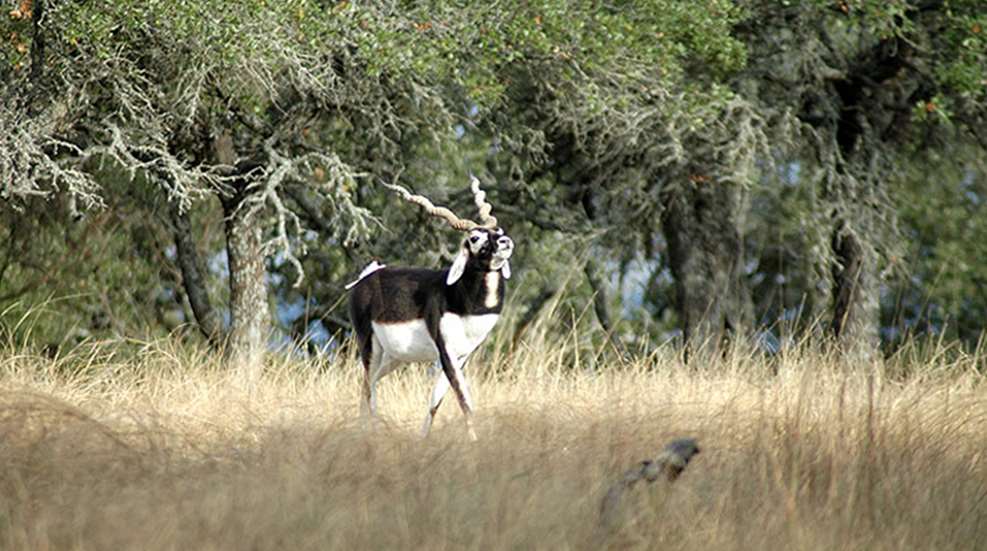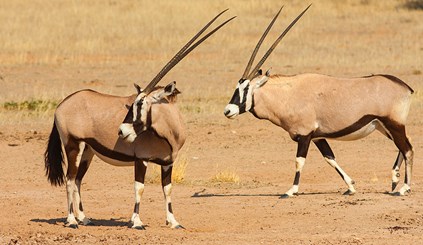
According to the Merriam-Webster online dictionary, a definition for the word exotic is: “Something introduced from another country or something not native to the place where it is found.” Another definition describes exotic as something strikingly, excitingly or mysteriously different or unusual. Both are appropriate when it comes to describing exotic game animals in the United States.
The hunting of exotic animals is most often associated with ranches, and it's most common in Texas, where ranch sizes can range from a few hundred acres up into the thousands. There are places in Texas where you can hunt almost any animal found in Africa, or Continental critters like the European red stag. Since these animals are not native to the United States and have not ever become part of the American free-ranging ecosystem, hunts of this type are generally considered “high-fence” hunts. Animals harvested on hunts like this are not eligible for Boone & Crockett or Pope & Young recognition.
There are also exotic animals that are free-ranging in America. By “free-ranging,” I mean running wild just like native animals like elk and grizzly bears. (Animals harvested on hunts like this are considered “fair chase,” as long as all local and national laws are obeyed.) What might surprise you is that several animals you might think are native to North America are actually exotics.
The most widely hunted exotic animal in North America is, believe it or not, the feral hog. The domestic pig was introduced to the Americas by the Spanish explorer DeSoto in the 1500s. Those that escaped captivity became feral and were hunted for food. Later, when the wild boar was introduced throughout the United States, they crossed with the feral hogs. Hunting wild hogs has become very popular because in most states they are considered a nuisance animal and seasons are year-round. Few hunters consider the wild hog an exotic, but it fits the definition-the pig is not native to North America. Their range is expanding, too. Initially wild hogs could only be found in the Southern states. Now, they have spread to almost every state and they continue to expand their range. This is partly because they multiply at such an amazing rate and partly because they have few natural predators to contend with.
I've hunted wild hogs in Oklahoma, Mississippi and Texas. They can be extremely challenging to stalk or stand hunt but are most often shot as they come into feeders. Wild hogs are certainly edible, but due to their diet and the amount of exercise they get, they're not going to be as tender as domestic pigs. (It's also very important to cook the meat of all pigs very thoroughly, as they can harbor parasites.)
Upland bird hunters across North America frequently pursue another exotic-you might know it as the ringneck pheasant. It was introduced to America in the 1850s. These exotic game birds are often called the Chinese pheasant because they originated in Asia. Because of their numbers and popularity people think of them as a native species so much that the common pheasant, as it is now called, is the state bird of South Dakota.
Axis deer were introduced in the United States in the 1930s. They have thrived and are the most common non-indigenous ungulate found in North America. Over the years axis deer escaped from game ranches...and there have also been free-range introductions, too. Today, huntable populations of axis deer are found over much of Texas. They are still considered an exotic as far as game laws are concerned, so the license is cheap and they can be hunted year-round.
Hunting exotic species in the U.S. can involve any number of hunting techniques. My first axis deer hunt was on a large ranch in Texas near the South Llano River. The only fence there was a low cattle fence. The axis deer that frequented the ranch could have walked to West Virginia had they been of a mind to do so. I hunted from a box blind set up near a feeder. This is a common practice for hunting whitetails in Texas, since the brush can be so thick as to be nearly impassable for people, but it's not necessarily my favorite way to hunt. (I did take a nice stag and the antlers are impressive.) Conversely, several years later I hunted axis again in Texas, but this time behind a high fence that surrounded thousands of acres. That time, we hunted strictly by spot and stalk. Finding an axis buck and getting close enough for a shot proved difficult. It was a thoroughly enjoyable hunt and that axis tasted just as good as the first one. Most hunters that have eaten axis deer meat agree they taste better than whitetails.
One appealing facet of the axis deer is that they breed year-round. Axis bucks grow and shed one set of antlers per year, but they do so based on when they were born. This can be at any time, so bucks in the same group can be seen with no antlers, velvet antlers or hard antlers. Hunting a stag or buck axis is not restricted to just a few months each year.
Axis deer are not the only free-ranging exotic animal you can hunt in Texas. One of my favorite critters to hunt is free-ranging aoudad, also known as Barbary sheep. (On my last aoudad hunt, the guide called them “doodads.”) The aoudad is a sheep native to North Africa, but these days they roam wild in the mountains of West Texas. It's technically not really a sheep; the aoudad is a “caprid” or goat-antelope. Sheep or goat, these “doodads” have exquisite eyesight and like to keep to the most rugged terrain you'll find in west Texas-in fact, today there are more aoudad in Texas than their native land. On my first aoudad hunt I walked and climbed hills until my knees begged for relief. Finally, on the fifth day, I managed to connect with one of these elusive animals with the wide curling horns.
The blackbuck and gemsbok are two other free-ranging, exotic antelope that can be hunted in North America. As a matter of fact, there are more blackbuck in Texas than in India, where they are indigenous and now considered endangered. Gemsbok (pictured above) were introduced to the White Sands Missile Range in New Mexico in 1969. They have established additional territory off the range and in Texas. Each year the New Mexico Fish & Game issues a limited number of hunting permits for these “oryx” (as they are also known). Gemsbok are one of Africa's most magnificent trophies. A free-ranging, North American hunt for gemsbok can be very similar to, and in some cases more challenging than, what you might experience hunting in South Africa. Interestingly, what I'll bet you don't know is that most all of the gemsbok hunted in South Africa are hunted behind high fences. So it's a little ironic that you've got a better chance to hunt free-ranging gemsbok in the United States than you would in its native country.
When it comes to hunting ethics or exotics, we must all make our own decision as to what is and is not acceptable. For example, in some counties in eastern Virginia it is perfectly legal to hunt whitetail deer with dogs. In South Africa, where hundreds of Americans go on safari every year, they will be hunting a high-fenced concession. What hunters should not do is discount the hunting of exotics as unethical or easy just because they are animals that are not from around here.
What's important, regardless of whether the game animal is an exotic or not, is the method in which the hunt is conducted and the interaction between the hunter and the hunted. With a bit of research you can find a suitable location where you can have an ethical hunt for animals that in many cases were not even on this continent just 100 years ago.
I'm eagerly awaiting my next aoudad hunt that I hope happens this fall. Thousands of upland bird hunters are anticipating the opening of pheasant season across the midwest. Year round, fathers, sons and daughters will be out looking for wild hogs to hunt and a few hunters are eagerly waiting to see if they will finally draw a New Mexico gemsbok tag. Exotics are fine game animals and if you have the chance you should try for one or more of these mysterious animals.
Lead photo of blackbuck by Nita Turpin, Lifetime Member of the Exotic Wildlife Association








































